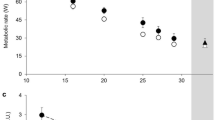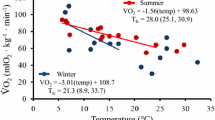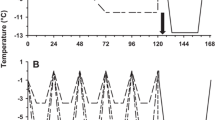Summary
Cold acclimation lowers the selected body temperature (T b) in many ectothermic vertebrates. This change in behavioural thermoregulation is accompanied by an increase in the proportion of polyunsaturated fatty acids in tissues and cellular membranes. We investigated how diets containing different fatty acids, known to significantly alter the fatty acid composition of animal tissues and membranes, affect the selected T b of the lizard Tiliqua rugosa. Lizards on a diet containing many polyunsaturated fatty acids (10% sunflower oil) showed a 3–5°C decrease in T b, whereas T b in animals on a diet containing mainly saturated fatty acids (10% sheep fat) did not change. Our study suggests that the composition of dietary lipids influences thermoregulation in ectothermic vertebrates and may thus play a role in the seasonal adjustment of their physiology.
Similar content being viewed by others
Abbreviations
- CST:
-
central standard time
- T a :
-
air temperature
- T b :
-
Body temperature
References
Cabanac M (1990) Phylogeny of fever. In: Bligh J, Voigt K (eds) Thermoreception and temperature regulation. Springer, Berlin Heidelberg New York, pp 284–296
Case TJ (1976) Seasonal aspect of thermoregulatory behavior in the chuckawalla, Sauromalus obesus (Reptilia, Lacertilia, Iguanidae). J Herpetol 10:85–95
Cossins AR, Bowler K (1987) Temperature biology of animals. Chapman and Hall, London
Cossins AR, Friedlander MJ, Prosser CL (1977) Correlation between behavioral temperature adaptations of goldfish and the viscosity and fatty acid composition of their synaptic membranes. J Comp Physiol 120:109–121
Fast PG (1970) Insect lipids. In: Holman RT (ed) Progress in the chemistry of fats and other lipids. Pergamon Press, Oxford, pp 181–242
Geiser F (1990) Influence of polyunsaturated and saturated dietary lipids on adipose tissue, brain, and mitochondrial membrane fatty acid composition of a mammalian hibernator. Biochim Biophys Acta 1046:159–166
Hazel JR (1988) Homeoviscous adaptation in animal cell membranes. In: Aloia RC, Curtain CC, Gordon LM (eds) Advances in membrane fluidity. Liss, New York, pp 149–188
Hazel JR, Prosser CL (1974) Molecular mechanisms of temperature compensation in poikilotherms. Physiol Rev 54:620–677
Huey RB (1982) Temperature, physiology, and ecology of reptiles. In: Gans C, Pough FH (eds) Biology of the Reptilia, vol 12. Academic Press, London, pp 25–91
Lehninger AL (1982) Principles of biochemistry. Worth, New York
Lepage G, Roy CC (1986) Direct transesterification of all classes of lipids in a one-step reaction. J Lipid Res 27:114–120
Lin MT (1984) Hypothalamic mechanisms of thermoregulation in the rat: neurochemical aspects. In: Hales JRS (ed) Thermal physiology. Raven Press, New York, pp 113–118
MacMillen RE, Augee ML, Ellis BA (1989) Thermal ecology and diet of some xerophilous lizards from western New South Wales (Australia). J Arid Environments 16:193–201
McMurchie EJ (1988) Dietary lipids and the regulation of membrane fluidity and function. In: Aloia RC, Curtain CC, Gordon LM (eds) Advances in membrane fluidity. Liss, New York, pp 189–237
Raison JK, Pike CS, Berry JA (1982) Growth-temperature-induced alterations in the thermotropic properties of Nerium oleander membrane lipids. Plant Physiol 70:215–218
Rismiller PD, Heldmaier G (1988) How photoperiod influences temperature selection in Lacerta viridis. Oecologia 75:125–131
White FN, Somero G (1982) Acid-base regulation and phospholipid adaptation to temperature: time-courses and physiological significance of modifying the milieu for protein function. Physiol Rev 62:40–90
Author information
Authors and Affiliations
Rights and permissions
About this article
Cite this article
Geiser, F., Firth, B.T. & Seymour, R.S. Polyunsaturated dietary lipids lower the selected body temperature of a lizard. J Comp Physiol B 162, 1–4 (1992). https://doi.org/10.1007/BF00257929
Accepted:
Issue Date:
DOI: https://doi.org/10.1007/BF00257929




